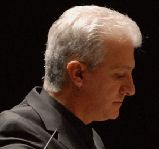|
Symphony
SRS SEASON ENDS WITH RESOUNDING TA-TA-TA-BANG
by Terry McNeill
Sunday, June 1, 2025
Symphony
YOUTHFUL VIRTUOSITY ON DISPLAY AT USO'S MAY CONCERTS
by Peter Lert
Saturday, May 17, 2025
Symphony
MYSTICAL PLANETS AND LIVELY GERSHWIN ORTIZ AT FINAL SRS CONCERT
by Peter Lert
Sunday, May 4, 2025
Symphony
VSO'S CONCERT MUSIC OF TIME, MUSIC OF PLACE
by Peter Lert
Sunday, April 27, 2025
Choral and Vocal
VOCAL ELEGANCE AND FIRE AT THE 222'S RECITAL APRIL 26
by Pamela Hicks Gailey
Saturday, April 26, 2025
CANTIAMO SONOMA SINGS AN INSPIRED GOOD FRIDAY MOZART REQUIEM CONCERT
by Pamela Hicks Gailey
Friday, April 18, 2025
DRAMATIC SHOSTAKOVICH SYMPHONY CLOSES PHILHARMONIC'S 25TH SEASON
by Terry McNeill
Sunday, April 13, 2025
LARGE COLLEGE OF MARIN AUDIENCE GREETS STOPHER ARTISTRY
by Terry McNeill
Saturday, April 5, 2025
Chamber
FRISSON DELIVERS SHIVERS OF DELIGHT
by Abby Wasserman
Sunday, March 30, 2025
OLD AND MOSTLY NEW IN SRS MARCH CONCERT IN WEILL
by Peter Lert
Saturday, March 22, 2025
|
 |
 Gabriel Sakakeeny |
A DECADE AND COUNTING
by Terry McNeill
Wednesday, October 15, 2008
An old business axiom has it that “ten years means a career,” and with the American Philharmonic Sonoma County making that anniversary, the tenth’s season first concerts October 11 and 12 brought more than the usual anticipation. This orchestra, which began in Cotati, has overcome manifold hurdles to become a formidable musical force in the North Bay.
A season-launching concert should open with something special, and Stephen Main’s “Overture for a New America” had a decidedly populist, perhaps even political tone. One of three world premieres to be played by the American Philharmonic this season, the Overture recalls a bucolic Vaughan-Williams, Respighi’s “Pines of Rome” and film scores such as Howard Shore’s “Lord of the Rings.” In three sections, the lush score portrays heroic aspects of the American national character with splendid writing for the brass and several full-orchestra climaxes. A fugue caps the third section, albeit breaking off too quickly, with the returning martial character winning out. It’s a substantial work with rich tonal colors, and it was elegantly played by the orchestra. The audience, filling perhaps half of the Wells Fargo Center’s 1,500 seats, loved it, and Main was introduced by conductor Gabriel Sakakeeny to additional acclaim.
Grieg’s A Minor Piano Concerto completed the first half, capably played by Rohnert Park resident Lauren Xie in her second appearance with the American Philharmonic. An early Grieg work, from 1868, the dramatic and melodic concerto preceded the other popular piano concertos of the time (Rubinstein D Minor, Tchaikovsky B-Flat, Brahms’s D Minor and B-Flat, Henselt’s F Minor) and has never lost hold of a wide public. Its soaring themes and perfect integration of the solo instrument and orchestra are models of the genre. In the first movement Xie chose to underplay the massive choral parts, playing cleanly and never rushing tempos. Her performance was certainly lyrical but lacked heft and excitement. The big trill entering the coda was bright, and finally she mounted a real forte in the coda.
Her best playing came in the Adagio in D Flat, despite orchestra pitch problems in the introduction. Here Xie’s thoughtful and tender interpretation was winning, her touch deft and shading subtle. Xie tends to ignore some interesting bass lines heard in performances of other pianists, but the nostalgic music, and the lovely accompaniment from the orchestra, made the movement memorable. A highlight of the afternoon.
The finale, beginning in A Minor and ending in A Major, was held in strict control by Sakakeeny’s precise baton, and the playing of the timpanist (unidentified in the program) was excellent. Xie was again best in lyrical parts, where the treble sustain in the piano carried well, and less convincing in fast pedaled runs where her scales lacked clarity. A standing ovation and four sets of flowers for the soloist followed the volcanic ending. Prior to the second half, Sakakeeny presented Xie with the Orchestra’s Young Artist Award, an annual gift and tribute to young musicians in the North Bay area.
A youthful and still amazing First Symphony in F Minor (1925) from Shostakovich closed the concert. In four movements, it must rank with Mahler’s as one of the best “first” symphonies ever written, and it has all the characteristics of the mature composer’s additional 14 works in the genre: brilliant orchestration, acerbic wit, blatant but proper theme-borrowing, and immense emotional impact. It has everywhere the distinctive Shostakovich voice, mixed in with climaxes recalling countrymen Scriabin and Tchaikovsky.
Tom Hyde’s solo trumpet playing throughout was exemplary. The grotesquerie of the Scherzo and the introversion of the slow movement (Lento) were fluently performed, with Steve Bergman (clarinet) Chris Crive (oboe) and Miranda Kincaid (bassoon) as standout soloists. But this is a symphony of solo parts, at times with even a bit of Wagner in the long fourth-movement introduction, and in that pesky Scherzo, which I suspect this orchestra could not have effectively tackled five years ago. Sakakeeny seems to keep setting the bar higher, with more demanding works that require large forces and presumably much rehearsal time, and the preparation was palpable in a masterful interpretation. The prevailing feeling of sadness was finally relieved by the massive ending statement from the horns.
Perhaps this performance indicates that a Shostakovich symphony could be on at least one American Philharmonic program each year? The Fourth may be still be out of reach, but this wonderful orchestra, playing last year the Rite of Spring and the Poem of Ecstasy, could probably do it.
|

